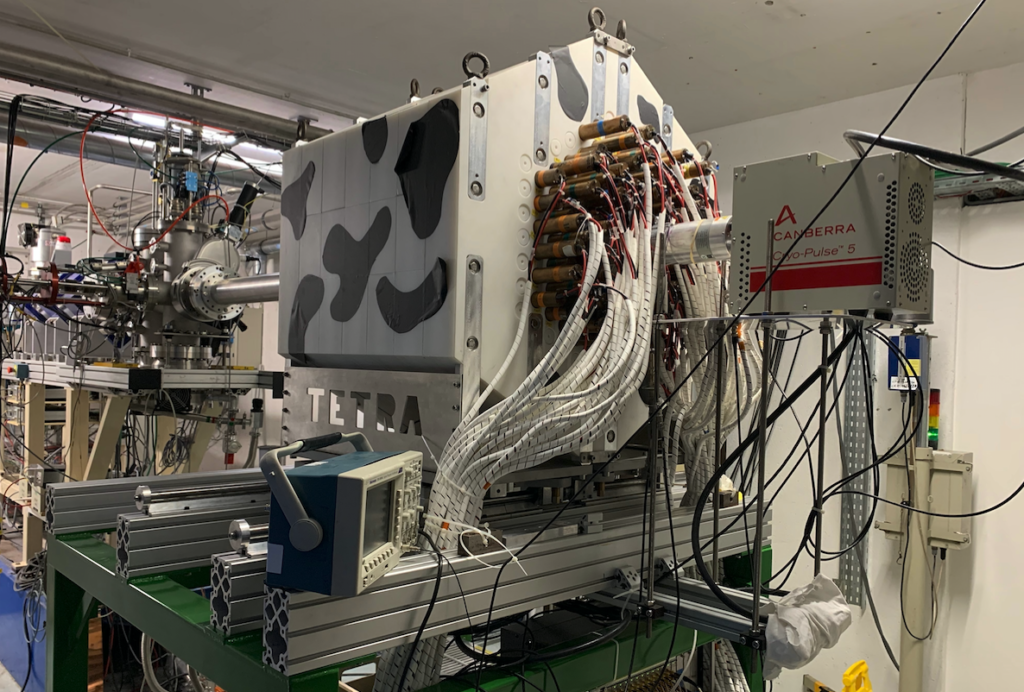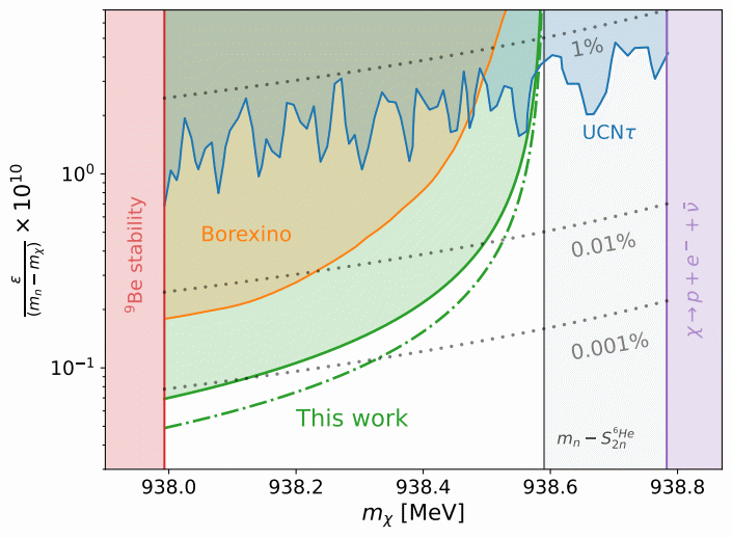- Homepage
- >
- Scientists
- >
- News & Highlights
- >
- 2024
- >
- Search for a neutron dark decay in ⁶He
Search for a neutron dark decay in ⁶He
The helium 6 nucleus was proposed as a potential candidate to probe the neutron dark decay model. Due to the purity and great intensity of the ⁶He⁺ radioactive beam (up to 300 million nuclei per second) produced by the GANIL SPIRAL1 facility, a strict upper limit of 4×10⁻¹⁰ has been set on the branching ratio for this exotic decay mode in helium 6. This limit strongly constrains both the dark decay model and its root, the neutron lifetime discrepancy.
The neutron lifetime discrepancy
A free neutron is a radioactive particle that will decay into a proton by emitting an electron and an antineutrino with a lifetime value of around 880 s. This is a very well-known process called a β decay. As the free neutron lifetime is a parameter of great importance in the Standard Model, its value must be known to a good degree of precision. For that reason, many experiments dedicated to its measurement have been performed since the 1950s, moving the value from 1108±216 seconds with Robson’s experiment in 1951, down to 877.75±0.36 seconds with the UCNτ experiment in 2021.
These neutron lifetime experiments are usually divided into two categories corresponding to the experimental method used. On one hand, the ‘beam’ method and, on the other, the ‘bottle’ method. In “beam” experiments, a cold neutron beam is produced and the neutron lifetime is extracted by comparing the intensity of the neutron beam with the rate of products (protons and/or electrons) emitted after the β decay. In “bottle” experiments, ultracold neutrons are stored inside a trap, and the lifetime is assessed by directly measuring the number of surviving neutrons in the trap after a defined stocking time.
The mean lifetime values for these two methods, as shown in Figure 1, are in disagreement with each other with a discrepancy of about 1\%. The incompatibility between the two error bars suggests the existence of a systematic effect that is not taken into account in either experimental approach. This tension between the “beam” and “bottle” values is known as the neutron lifetime discrepancy.

Neutron dark decay
The “bottle” method directly follows the evolution in time of a population of ultracold neutrons and, therefore, should give access to the total neutron lifetime. On the other hand, the ‘beam’ method specifically looks at products emitted after a neutron β decay. In principle, this approach should only measure the partial neutron lifetime associated with this β decay mode. Therefore, in 2018 it was proposed that a free neutron could have another decay channel available that involved dark matter particles in the final state with a branching ratio of 1\%. As the “beam” experiments are not sensitive to this new type of decay mode, this could be an explanation for the discrepancy observed between the two mean neutron lifetime values.
If there is a dark decay of free neutrons, it should also occur in a selection of nuclei with specific properties. The helium 6 nucleus is one of them. It is a borromean nucleus composed of a helium 4 core with two weakly bound halo neutrons that can be considered as “quasi-free” neutrons. If one of these halo neutrons undergoes a dark decay, the other one would automatically be freed and emitted in the environment. Such a neutron emission is not expected in a standard helium 6 decay. Indeed, the neutron emission threshold is not energetically accessible for a helium 6 nucleus in its ground state. Nevertheless, it is allowed in this new dark decay framework and would therefore be a unique signature of dark matter creation.
This exotic decay mode was investigated using the radioactive helium 6 beam produced by the GANIL SPIRAL1 facility coupled to the high-efficiency neutron detector TETRA (see Figure 2) from collaboration with IJCLab. The beam was transported at a very low energy inside a thin 150 um aluminum foil at the center of the experimental setup. In a typical cycle, the beam was implanted for 3 seconds inside the foil and cut for 7 seconds. In the case of a neutron dark decay in helium 6, the number of neutrons detected with TETRA should rise and fall with respect to the implanted and surviving population of helium 6 nuclei implanted within a cycle.

This experiment performed at GANIL allowed us to establish an upper limit to the branching ratio value for this dark decay mode in helium 6 at 4×10⁻¹⁰. This experimental limit was then translated to further constrain the theoretical model and its parameter space as shown in Figure 3. This result coupled to other approaches (Borexino and UCNτ) points to the conclusion that a neutron dark is a priori not the main cause behind the neutron lifetime discrepancy.

Contact : Marius Lejoubioux – marius.lejoubioux@ganil.fr
Référence : https://journals.aps.org/prl/abstract/10.1103/PhysRevLett.132.132501
